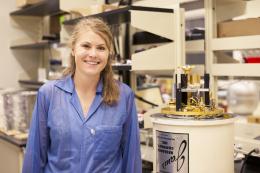This is the unofficial website of the NSF AAPF program, run by the fellows themselves. For official information about the fellowship, please go to the NSF program announcement.
Kristina Davis

I am a member of Ben Mazin's research group at UC Santa Barbara working on imaging nearby exoplanets with near-IR microwave kinetic inductance (MKID) arrays from ground-based observatories. My research focuses on deepening the contrast in images of exoplanetary systems, enabling detection of Earth-sized planets around their host star. The current image background noise level is determined by the level of atmospheric 'speckles' in the image, which arise when the deformable mirror (DM) of the telescope's adaptive optics (AO) system cannot properly remove stray starlight due to atmospheric turbulence. Active speckle nulling is achieved by first inducing a modulated probe pattern on the DM, and separating coherent speckles from incoherent planetary signals. Once a speckle is identified, it is nulled by imposing a phase-shifted coherent signal at the speckle location on the DM. I am helping develop an algorithm that uses the high readout rate of the MKID array to feed a secondary control loop to the AO system to make these corrections in real time.
I am developing a web-based video tutorial series for teacher development training on a STEM activity I will develop focused on teaching MKID operation and resonant phenomenon to high-school students. MKID detectors are micro-resonators, where each pixel is tuned to a different frequency. The array is read-out by recording a de-tuning of the resonator during photon absorption. The STEM lesson begins by teaching resonant phoenomenon to the students via sound waves, and advances to electrical signals by having the students construct and test small A.M. radio receiver circuits. These concepts are then applied to understanding MKID readout electronics basics.